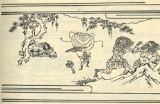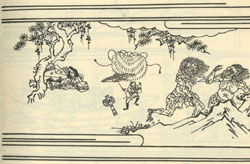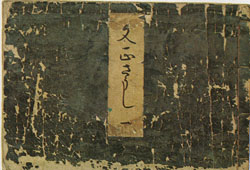
Otogizoshi
Encyclopedia

Muromachi period
The is a division of Japanese history running from approximately 1336 to 1573. The period marks the governance of the Muromachi or Ashikaga shogunate, which was officially established in 1338 by the first Muromachi shogun, Ashikaga Takauji, two years after the brief Kemmu restoration of imperial...
(1392–1573). These illustrated short stories, which remain unattributed, together form one of the representative literary genres of the Japanese medieval era.
Overview
This type of short prose narrative from JapanJapan
Japan is an island nation in East Asia. Located in the Pacific Ocean, it lies to the east of the Sea of Japan, China, North Korea, South Korea and Russia, stretching from the Sea of Okhotsk in the north to the East China Sea and Taiwan in the south...
is often considered a transitional genre, which bridges the gap between the courtly literature of the Heian period
Heian period
The is the last division of classical Japanese history, running from 794 to 1185. The period is named after the capital city of Heian-kyō, or modern Kyōto. It is the period in Japanese history when Buddhism, Taoism and other Chinese influences were at their height...
(794-1160) and the more plebeian
Plebs
The plebs was the general body of free land-owning Roman citizens in Ancient Rome. They were distinct from the higher order of the patricians. A member of the plebs was known as a plebeian...
kanazōshi
Kanazoshi
describes a type of printed Japanese book that was produced primarily in Kyoto between 1600 and 1680. The term literally means “books written in kana”...
(tales written in kana
Kana
Kana are the syllabic Japanese scripts, as opposed to the logographic Chinese characters known in Japan as kanji and the Roman alphabet known as rōmaji...
) and ukiyozōshi
Ukiyozoshi
is the first major genre of popular Japanese fiction, written between the 1680s and the 1770s in Kyoto and Osaka. Ukiyozōshi literature developed from the kanazōshi genre and was in fact initially classified as kanazōshi...
(tales of the floating world) of the Edo period
Edo period
The , or , is a division of Japanese history which was ruled by the shoguns of the Tokugawa family, running from 1603 to 1868. The political entity of this period was the Tokugawa shogunate....
(1600–1868). The stories were originally recorded in both illustrated scrolls or booklets (Nara-ehon) which link the picture scrolls of the Heian era with the woodblock print books of the Edo period. This suggests that otogizōshi were meant to be read aloud, with the illustrations serving as reference guides.
Because the stories were frequently recited before an audience, many narratives are simple, with little description, depth, or development. Others, however, are more poetically allusive, suggesting composition by literati. Many of the tales are straightforward quest
Quest
In mythology and literature, a quest, a journey towards a goal, serves as a plot device and as a symbol. Quests appear in the folklore of every nation and also figure prominently in non-national cultures. In literature, the objects of quests require great exertion on the part of the hero, and...
narratives, often revolving around a single heroic figure. In order to advance the plot, the passage of time is swift, with characters sometimes aging years or decades in the space of a single sentence.
The vast topical range of Otogizōshi discourages easy generalization. The subject matter includes worldly concerns (love, marriage, family); spiritual matters (the pursuit of enlightenment, encounters with manifestations of the Buddha); martial adventures; farce, and supernatural fantasy. While some of the stories exhibit a clear didactic agenda, most otogizōshi appear to have been composed primarily for the sake of entertainment.
Categories of otogizōshi

Aristocracy
Aristocracy , is a form of government in which a few elite citizens rule. The term derives from the Greek aristokratia, meaning "rule of the best". In origin in Ancient Greece, it was conceived of as rule by the best qualified citizens, and contrasted with monarchy...
, which are derived from earlier works such as The Tale of Genji
The Tale of Genji
is a classic work of Japanese literature attributed to the Japanese noblewoman Murasaki Shikibu in the early 11th century, around the peak of the Heian period. It is sometimes called the world's first novel, the first modern novel, the first psychological novel or the first novel still to be...
, The Tale of the Heike
The Tale of the Heike
is an epic account of the struggle between the Taira and Minamoto clans for control of Japan at the end of the 12th century in the Genpei War...
and Taiheiki
Taiheiki
The is a Japanese historical epic , written in the late 14th century. It deals primarily with the Nanboku-chō, the period of war between the Northern Court of Ashikaga Takauji in Kyoto, and the Southern Court of Emperor Go-Daigo in Yoshino....
; religious tales; tales of warriors, often based on the The Tale of the Soga and The Tale of Yoshitsune; tales of foreign countries, based on the Konjaku Monogatarishū
Konjaku Monogatarishu
is a Japanese collection of over one thousand tales written during the late Heian period . The entire collection was originally contained in 31 volumes, of which only 28 remain today...
. The most well-known of the tales, however, are retellings of familiar legend
Japanese mythology
Japanese mythology is a system of beliefs that embraces Shinto and Buddhist traditions as well as agriculturally based folk religion. The Shinto pantheon comprises innumerable kami...
s and folktale
Japanese folklore
The folklore of Japan is heavily influenced by both Shinto and Buddhism, the two primary religions in the country. It often involves humorous or bizarre characters and situations and also includes an assortment of supernatural beings, such as bodhisattva, kami , yōkai , yūrei ,...
s, such as Issun-bōshi, the story of a one-inch-tall boy who overcomes countless obstacles to achieve success in the capital.
Origins of the term otogizōshi
The term otogi literally means "companionCompanion
Companion may refer to:* A friend or acquaintance you associate yourself with* Companion , a nurse assistant or similar professional who assists a patient one-on-one* Companion , an architectural feature of ships...
", with the full name of the genre translating to "companion tale". This designation, however, did not come into use until 1725, when a publisher from Osaka
Osaka
is a city in the Kansai region of Japan's main island of Honshu, a designated city under the Local Autonomy Law, the capital city of Osaka Prefecture and also the biggest part of Keihanshin area, which is represented by three major cities of Japan, Kyoto, Osaka and Kobe...
released a set of 23 illustrated booklets titled Shūgen otogibunko (Fortuitous Companion Library). As other publishers produced their own versions of Shūgen otogibunko, they began referring to the set of tales as otogizōshi. Gradually the term came to describe any work from the Muromachi or early Edo period that exhibited the same general style as the tales in Shūgen otogibunko.
History of otogizōshi scholarship
Otogizōshi came to the attention of modern literary historianLiterary criticism
Literary criticism is the study, evaluation, and interpretation of literature. Modern literary criticism is often informed by literary theory, which is the philosophical discussion of its methods and goals...
s in the late nineteenth century. For the most part, scholars have been critical of this genre, dismissing it for its perceived faults when compared to the aristocratic literature of the Heian and Kamakura periods. As a result, standardized Japanese school
Education in Japan
In Japan, education is compulsory at the elementary and lower secondary levels. Approximately 98% of all students progress to the upper secondary level, which is voluntary . Most students attend public schools through the lower secondary level, but private education is popular at the upper...
textbook
Textbook
A textbook or coursebook is a manual of instruction in any branch of study. Textbooks are produced according to the demands of educational institutions...
s often omit any reference to otogizōshi from their discussions of medieval Japanese literature. Recent studies, however, have contradicted this critical stance, highlighting the vitality and inherent appeal of this underappreciated genre. The term "chusei shosetsu" (medieval novels, coined by eminent scholar Ichiko Teiji, attempts to situate the tales within a narrative continuim.
External links
- "Sekai no Dejitaru Nara Ehon Detabesu" at Keiō University
- Translations of Classical Japanese Works, Meiji Gakuin UniversityMeiji Gakuin Universityis one of the Christian universities in Tokyo and Yokohama which was established in 1863. The Reverend Dr. James Curtis Hepburn was one of the founders and the first president...
- Online edition of the Otogizōshi at Kyoto University

